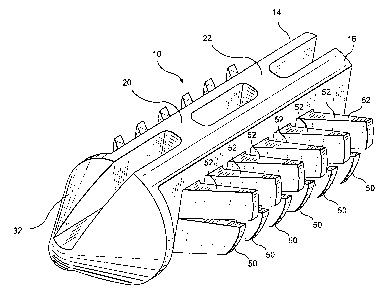Some of the information on this Web page has been provided by external sources. The Government of Canada is not responsible for the accuracy, reliability or currency of the information supplied by external sources. Users wishing to rely upon this information should consult directly with the source of the information. Content provided by external sources is not subject to official languages, privacy and accessibility requirements.
Any discrepancies in the text and image of the Claims and Abstract are due to differing posting times. Text of the Claims and Abstract are posted:
| (12) Patent: | (11) CA 2262157 |
|---|---|
| (54) English Title: | TREE FASTENER WITH SPLIT WINGS |
| (54) French Title: | GOUJON D'ASSEMBLAGE A AILETTES FENDUES |
| Status: | Expired and beyond the Period of Reversal |
| (51) International Patent Classification (IPC): |
|
|---|---|
| (72) Inventors : |
|
| (73) Owners : |
|
| (71) Applicants : |
|
| (74) Agent: | FINLAYSON & SINGLEHURST |
| (74) Associate agent: | |
| (45) Issued: | 2003-04-29 |
| (22) Filed Date: | 1999-02-16 |
| (41) Open to Public Inspection: | 1999-08-24 |
| Examination requested: | 1999-02-16 |
| Availability of licence: | N/A |
| Dedicated to the Public: | N/A |
| (25) Language of filing: | English |
| Patent Cooperation Treaty (PCT): | No |
|---|
| (30) Application Priority Data: | ||||||
|---|---|---|---|---|---|---|
|
The tree fastener includes a shank, a head and wings on
first and second opposed sides of the shank. The wings are split
along the tool parting line into wing portions which extend from
the shank at different angles so that the spacing between wing
portions is one half the distance between successive wings.
Additionally, the wing portions are diagonally paired so that
wing portions on a first opposed side of the shank and a first
side of the tool parting line extend from the shank at the same
angle as wing portions on a second opposed side of the shank and
a second side of the tool parting line. Likewise, wing portions
on a second side of the shank and a first side of the tool
parting line extend from the shank at the same angle as wing
portions on a first side of the shank and a second side of the
tool parting line.
Note: Claims are shown in the official language in which they were submitted.
Note: Descriptions are shown in the official language in which they were submitted.

2024-08-01:As part of the Next Generation Patents (NGP) transition, the Canadian Patents Database (CPD) now contains a more detailed Event History, which replicates the Event Log of our new back-office solution.
Please note that "Inactive:" events refers to events no longer in use in our new back-office solution.
For a clearer understanding of the status of the application/patent presented on this page, the site Disclaimer , as well as the definitions for Patent , Event History , Maintenance Fee and Payment History should be consulted.
| Description | Date |
|---|---|
| Time Limit for Reversal Expired | 2011-02-16 |
| Letter Sent | 2010-02-16 |
| Grant by Issuance | 2003-04-29 |
| Inactive: Cover page published | 2003-04-28 |
| Inactive: Final fee received | 2003-01-29 |
| Pre-grant | 2003-01-29 |
| Notice of Allowance is Issued | 2002-08-09 |
| Letter Sent | 2002-08-09 |
| Notice of Allowance is Issued | 2002-08-09 |
| Inactive: Approved for allowance (AFA) | 2002-07-30 |
| Amendment Received - Voluntary Amendment | 2002-05-06 |
| Inactive: S.30(2) Rules - Examiner requisition | 2001-12-10 |
| Application Published (Open to Public Inspection) | 1999-08-24 |
| Inactive: Cover page published | 1999-08-23 |
| Inactive: IPC assigned | 1999-03-31 |
| Classification Modified | 1999-03-31 |
| Inactive: IPC assigned | 1999-03-31 |
| Inactive: First IPC assigned | 1999-03-31 |
| Inactive: Filing certificate - RFE (English) | 1999-03-17 |
| Filing Requirements Determined Compliant | 1999-03-17 |
| Application Received - Regular National | 1999-03-16 |
| Request for Examination Requirements Determined Compliant | 1999-02-16 |
| All Requirements for Examination Determined Compliant | 1999-02-16 |
There is no abandonment history.
The last payment was received on 2003-02-11
Note : If the full payment has not been received on or before the date indicated, a further fee may be required which may be one of the following
Please refer to the CIPO Patent Fees web page to see all current fee amounts.
| Fee Type | Anniversary Year | Due Date | Paid Date |
|---|---|---|---|
| Request for examination - standard | 1999-02-16 | ||
| Application fee - standard | 1999-02-16 | ||
| Registration of a document | 1999-02-16 | ||
| MF (application, 2nd anniv.) - standard | 02 | 2001-02-16 | 2001-02-05 |
| MF (application, 3rd anniv.) - standard | 03 | 2002-02-18 | 2002-02-01 |
| Final fee - standard | 2003-01-29 | ||
| MF (application, 4th anniv.) - standard | 04 | 2003-02-17 | 2003-02-11 |
| MF (patent, 5th anniv.) - standard | 2004-02-16 | 2004-02-03 | |
| MF (patent, 6th anniv.) - standard | 2005-02-16 | 2005-02-02 | |
| MF (patent, 7th anniv.) - standard | 2006-02-16 | 2006-01-30 | |
| MF (patent, 8th anniv.) - standard | 2007-02-16 | 2007-01-30 | |
| MF (patent, 9th anniv.) - standard | 2008-02-18 | 2008-01-30 | |
| MF (patent, 10th anniv.) - standard | 2009-02-16 | 2009-01-30 |
Note: Records showing the ownership history in alphabetical order.
| Current Owners on Record |
|---|
| ILLINOIS TOOL WORKS INC. |
| Past Owners on Record |
|---|
| CHARLES MEYER |